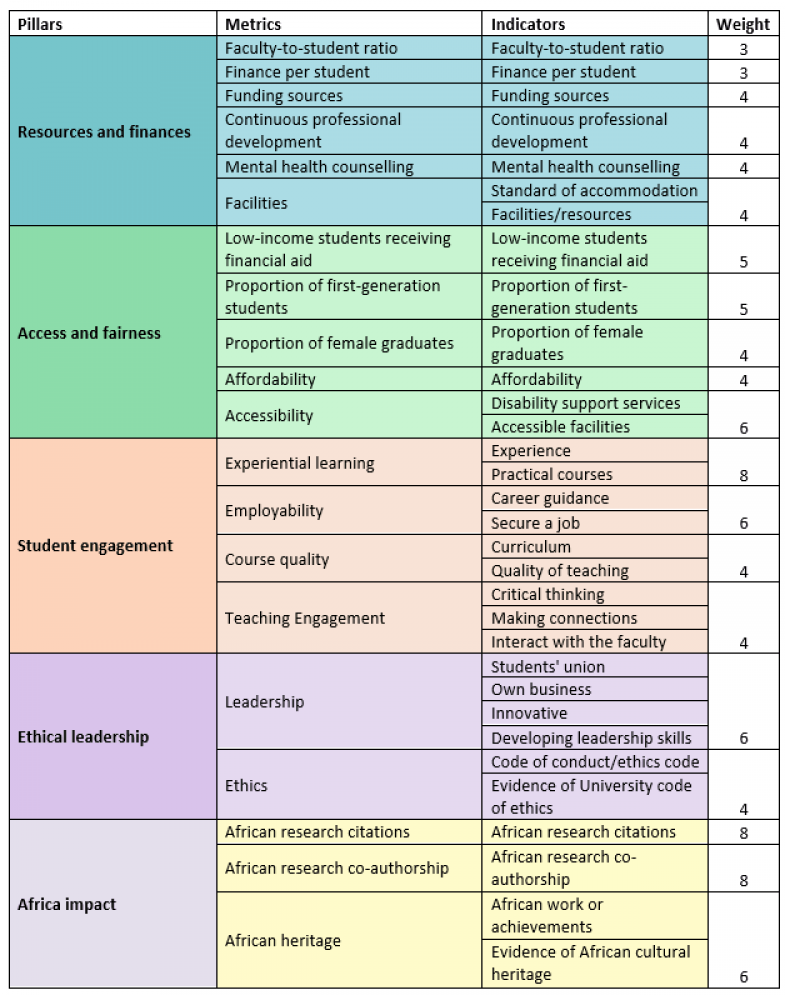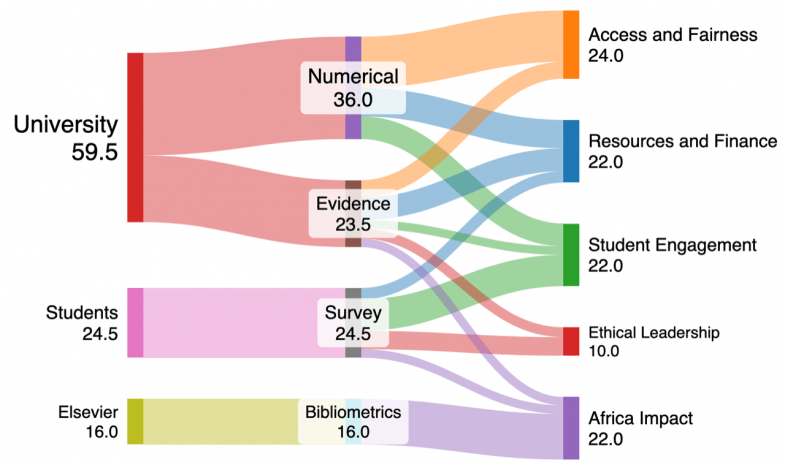The Sub-Saharan Africa University Rankings will be published on 27 November
The Times Higher Education Sub-Saharan Africa University Rankings were developed specifically to address the challenges faced by higher education institutions in sub-Saharan Africa (SSA).
The methodology for the rankings was developed by THE’s data team, in consultation with university leaders across Sub-Saharan Africa, under a project initiated by a consortium of African and international higher education organisations, in partnership with the Mastercard Foundation.
The ranking follows a hybrid methodology to account for the diverse strengths of the sector; unlike our other rankings, which tend to focus on one mission, it covers elements of teaching, impact and research.
This second edition of the rankings introduces significant updates to the original methodology. After consultation with university stakeholders in SSA, we added a new pillar – ethical leadership – as well as some new metrics. We have reorganised existing metrics to fit around this new structure, and also removed some metrics. Changes are detailed in the relevant pillar sections below. When metrics are composed of more than one indicator, those are indicated in italics.
Some changes to institutions’ scores will be influenced by these methodological adjustments, and we would advise noting that when making comparisons with the previous year’s results.
The overall methodology explores five key areas, which we call pillars.

The data
Data collected for this ranking includes data provided directly by universities (continuous data as well as evidence data, which follows the logic of the data we collect in our Impact Rankings), data collected from current students (as part of the student survey) and data supplied by our partner Elsevier (bibliometrics data).
This year, the student survey collected the opinions of more than 23,000 students from 129 institutions. THE is grateful to participating institutions for their efforts in distributing the survey to their students; this has enabled the collection of a rich dataset that highlights the particularities of higher education in the region. The student survey data used in the rankings combines responses from the 2024 survey and those collected in 2023.

Resources and finance
This pillar rewards financially stable institutions that are able to provide a high-quality learning experience.
It includes metrics on finance (income) per student (3%), which shows whether the institution has the money to effectively deliver teaching, and the faculty-to-student ratio (3%), which gives a sense of whether it has enough teaching staff to provide interactive learning.
To account for the financial stability of institutions, we look at the diversity of funding sources (4%), which measures how well distributed the funding system of the institution is (and how resilient it might be to sudden drought from any source).
We also look at how students rate the quality of the facilities (4%) and whether institutions offer (and require) continuous professional development (4%) to/from their teaching staff, as well as offer their students mental health counselling (4%) (free or not).
Access and fairness
With this pillar, we aim to account for the openness of institutions to students of all backgrounds, and how institutions ensure that all can succeed.
The metrics that comprise it measure the percentage of first-generation students (5%) as well as low-income students (5%) (who receive poverty-linked financial aid); we also measure the proportion of female graduates (4%).
One evidence-based metric looks at accessibility (disability access and disability support, 6%). An additional metric for this ranking is affordability (4%), which considers the median tuition and fees paid by students.
Those five metrics are all based on measurements present in our Impact Rankings – SDG 1 (No poverty), SDG 5 (Gender equality) and SDG 10 (Reduced inequalities).
Next, we look at the educational process itself. Last year, this was split into two pillars, but this year these have been combined into a single pillar.
Student engagement
In this pillar, we measure the skills-building that institutions provide, and their ability to equip students with the required tools to enter and be successful in the world of work. We also assess the more intangible benefits of education.
We measure the percentage of undergraduate students who encounter experiential learning (both practical learning courses and experiential learning, 8%) during their year.
We also evaluate employability (6%) by asking students whether the teaching they are receiving will help them secure a job after they graduate (employability), and asking universities about what career guidance services they provide.
As part of the student survey, we also assess universities’ course quality (teaching quality and curriculum, 4%), as well as student engagement (by asking students to what extent teaching at the university supports critical thinking and making connections among the things they have learned, and provides opportunities for interaction with faculty, 4%).
Ethical leadership
This new pillar was created to address specific challenges that were raised in our engagement with SSA universities – namely the need for higher education institutions to train the leaders of tomorrow that the region needs, with an emphasis on ethical values.
The first metric is concerned with leadership (6%), and aims to reward universities that foster the growth of leadership skills through curricular and extracurricular activities. We ask students about activities that build their leadership skills, encourage them to be innovative and equip them with an entrepreneurial mindset and skills. We also ask universities whether they recognise an independent students’ union.
To assess universities’ and students’ engagement with ethics (4%), we ask both students and universities about the dissemination of a code of conduct/ethics.
Africa impact
This final pillar is concerned with the ways in which higher education can be a force for good in the region and can help to build a rich collaborative network.
We look at the research produced by institutions: is this research used by other researchers in Africa (African citation – 8%), and is it the result of African collaboration (African co-authorship – 8%)? Those two measures are normalised by the total relevant research output.
A new metric this year, African heritage (6%), assesses universities’ efforts in fostering a sense of African pride by preserving local cultural heritage and recognising African achievements. To measure this, we ask universities whether they work to preserve African heritage, and students whether their courses discuss notable African work and achievements in the field.
Inclusion criteria
This year, a total of 171 universities participated in the data collection. Of those, 129 also had enough student survey responses (the minimum required is 50 valid responses): this is a requirement to be featured in the ranking.
The only requirement to participate in the SSA ranking is to teach undergraduate students. We welcome participation from a wide range of institutions, from large public universities to small vocational schools.




